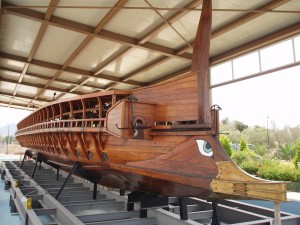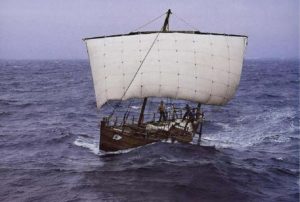If you are not an expert historian, you might start with a brief historical overview of ancient seafaring.
If you are interested in wind action on ships, in sailing rigs, in sailing the mediterranean Sea and the Red Sea, have a look at “Ancient sailing” hereafter.
Perhaps you would like to know more about the “Gubernator” of the ship.
If you are interested in ancient anchors, you might start with Peta Knott and with Greg Votruba.
If you are interested in ancient trade networks and intermodal hubs, have a look at “Ancient maritime trade” hereafter.
Let’s distinguish galleys (navis longis, longboats, warships) and merchant ships (navis oneraria, strongyla ploia, round ships).
Let’s start by saying that ancient ships were the most elaborate technology of the ancient world. Let’s note also that all galleys were not exclusively warships, as many early merchant ships were oared, and that most galleys had sails on board. But, generally speaking, oared (war)ships were long and narrow (length/beam ratio of ca. 7:1) and sailing merchant ships were bulkier (length/beam ratio of 3 to 4:1).
We badly miss pictures of ancient ships and we have to rely solely on reliefs, mosaics and ceramics and on modern artwork based on what we think we understand about ancient ships. A number of wrecks of merchant ships have been found, but very few ancient texts to describe them (one noteworthy exception: the Isis, by Lucian of Samosate). The reverse is true for war ships as only one wreck was found so far (the Marsala Punic ship, found in 1969), and some bronze rams described by Murray, including the 465 kg Athlit ram found in 1980. An explanation may be that merchant ships sunk with their cargo so that at least the bottom of the ship was preserved, while war ships were destroyed and their wooden structure was scattered around, except the rams.

One of the best modern “images” is the reconstruction of an Athenian Trireme at scale one in the Olympias Project of J.S. Morrison, J.F. Coates et N.B. Rankov between 1987 and 1994. The project still survives on internet thanks to the “Trireme Trust“.

The Kyrenia II experiment (1986-87) reproducing a small 30 ton merchant freighter of 14.5 x 4.5 m showed that she could resist a Force 9-10 Bft storm (Wikipedia) (Katzev, 1987).
This page also provides 3 tables :
- known ancient maxi-ships
- other ancient ships
- pm: the Maltese galley
For further details on ancient ships, refer to the following major contributions:
CASSON, L., 1995, “Ships and seamanship in the ancient world”, Johns Hopkins University Press, (470 p).
MURRAY, W. M., 2012, “The Age of Titans, the rise and fall of the great Hellenistic navies”, Oxford University Press, (356 p).
PITASSI, M., 2023, “Hellenistic Naval Warfare and Warships 336-30 BC”, Pen & Sword Books Ltd, (320 p).
KATZEV, M., 1987, “An analysis of the experimental voyages of Kyrenia II”, Tropis II, 2nd international symposium on ship construction in antiquity, Delphi, edt. Harry Tzalas, (p 245-255).
